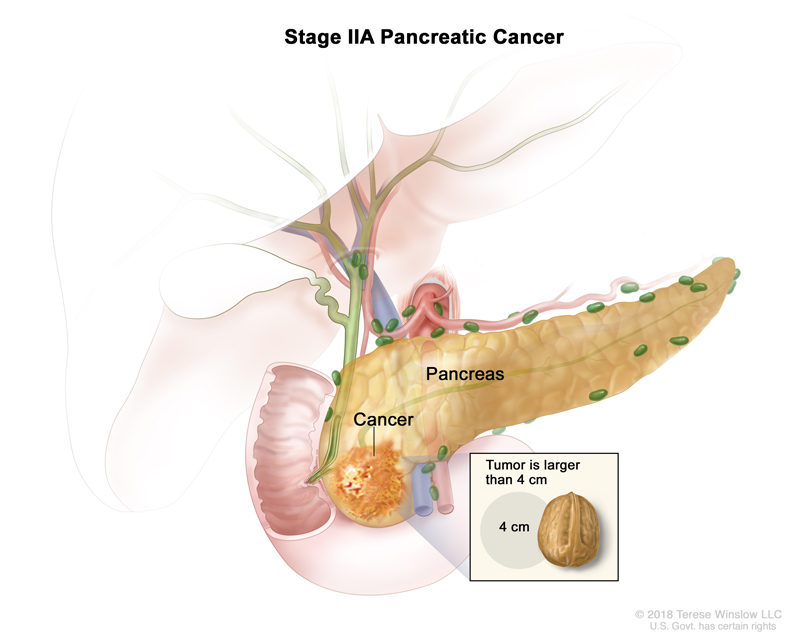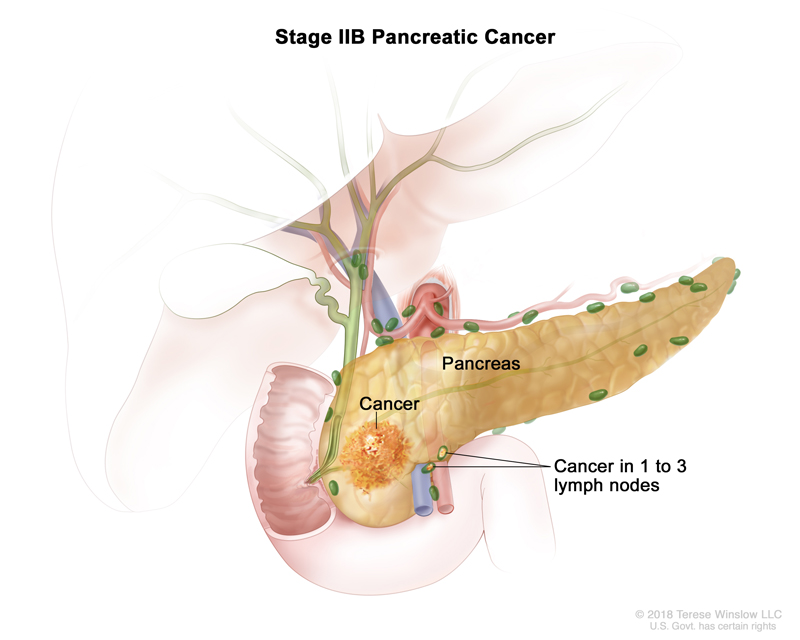Stage 2 Pancreatic Cancer is divided into Stages 2A and 2B. The sub-Stage depends upon the size of the tumor and where the cancer has spread.
Understanding your Stage 2 Pancreatic Cancer diagnosis will help you partner with your doctors to make the best treatment choice for you. Tap “Watch Now” for an easy-to-understand overview of Stage 2 Pancreatic Cancer.
- Stage 2A Pancreatic Cancer
- Stage 2B Pancreatic Cancer
Overview
A Pancreatic Cancer diagnosis is when cancer has been found in the tissues of your pancreas.
A Stage 2A Pancreatic Cancer diagnosis means that the tumor is larger than 4 centimeters, as shown here at the bottom of the image. It’s about the size of a walnut.
What Tests Will I Need and Why?
Blood and Imaging tests are done to understand your general health, confirm your diagnosis and determine your cancer stage.
Tissue analysis can be done to identify the cancer cell type, which is critical to finding the best treatment option for you.
You may also require special Saliva or Blood Analysis to look for specific mutations (actual changes in your body’s DNA), called BRCA1 and BRCA2.
If your treatment team has not already performed tests to determine your cancer’s features, please ask your doctor when these tests will be performed.
Re-read this summary as needed and then tap, “Compare My Treatment Options Now“. Our unique Comparison Page will help you understand your FDA-approved treatment options including, who can help you pay for your treatment, where and how each is given and what side-effects you may experience.

National Institute of Health/ treatment-pancreatic
Overview
A Pancreatic Cancer diagnosis is when cancer has been found in the tissues of your pancreas.
A Stage 2B Pancreatic Cancer diagnosis means that your tumor is any size and the cancer has spread to 1 to 3 nearby lymph nodes, shown here in green.
What Tests Will I Need and Why?
Blood and Imaging tests are done to understand your general health, confirm your diagnosis and determine your cancer stage.
Tissue analysis can be done to identify the cancer cell type, which is critical to finding the best treatment option for you.
You may also require special Saliva or Blood Analysis to look for specific mutations (actual changes in your body’s DNA), called BRCA1 and BRCA2.
If your treatment team has not already performed tests to determine your cancer’s features, please ask your doctor when these tests will be performed.
Re-read this summary as needed and then tap, “Compare My Treatment Options Now“. Our unique Comparison Page will help you understand your FDA-approved treatment options including, who can help you pay for your treatment, where and how each is given and what side-effects you may experience.

National Institute of Health/ treatment-pancreatic
Recommended Pancreatic Cancer Videos

Pancreatic Cancer: Treatment and Outcomes
Overview, Treatment and Outcomes

Pancreatic Cancer: Diet & Nutrition
Managing Pancreatic Cancer

How Cancer Spreads
Metastatic = Advanced

Diagnosing Your Cancer
How Does a CT Scan Work?

Diagnosing Your Cancer
How Does a PET Scan Work?

Exercise! You Can Do It
Reducing Side Effects & More
Commonly Searched Questions
Stage 2 Pancreatic Cancer Definition
This stage is considered locally advanced, which means it has spread outside the pancreas, to nearby blood vessels, to nearby lymph nodes or a mix of these, but has not spread to another organ. In stage IIA, the tumor extends outside the pancreas but has not spread to major nearby arteries or lymph nodes. In stage IIB, the tumor may extend outside the pancreas and has spread to nearby lymph nodes but not major nearby arteries.
Source: Cancer.org
Stage 2 Pancreatic Cancer Survival Rate
The overall 5-year survival rate of stage 2 Pancreatic Cancer is about 5 to 7% while for those resectable is about 52%.
Source: Cancer.org
Stage 2 Pancreatic Cancer Treatment
It involves surgery and some patients may need chemotherapy, radiotherapy, hormone therapy or targeted therapy. Now click here to Compare Your Latest Treatment Options.
Source: Cancer.org
Stage 2 Pancreatic Cancer Symptoms
Signs and symptoms of pancreatic cancer often don’t occur until the disease is advanced. They may include:
- Abdominal pain that radiates to your back
- Loss of appetite or unintended weight loss
- Yellowing of your skin and the whites of your eyes (jaundice)
- Light-colored stools
- Dark-colored urine
- Itchy skin
Source: Mayoclinic.org
Stage 2 Pancreatic Cancer Recurrence Rate
The recurrence rate for Stage 2 pancreatic cancer varies, but it is generally higher than for Stage 1 due to the more advanced nature of the disease. Stage 2 pancreatic cancer has spread beyond the pancreas but is still localized to nearby structures or lymph nodes. The likelihood of recurrence depends on factors such as the effectiveness of initial treatment, including surgery, chemotherapy, and radiation. Studies indicate that a significant portion of patients with Stage 2 pancreatic cancer experience recurrence, with many relapsing within a few years after treatment. For detailed statistics, consulting recent research or a healthcare professional is recommended.
Source: Cancer.gov
Stage 2 Pancreatic Cancer Prevention
Specific prevention strategies for Stage 2 Pancreatic Cancer are not outlined. However, general recommendations to reduce the risk of pancreatic cancer include:
- Healthy Diet: Eat a diet rich in fruits, vegetables, and whole grains.
- Maintain a Healthy Weight: Achieve and maintain a healthy weight through balanced diet and regular exercise.
- Avoid Smoking: Do not smoke and avoid exposure to secondhand smoke.
- Limit Alcohol: Consume alcohol in moderation, if at all.
- Manage Chronic Conditions: Effectively manage conditions like diabetes and chronic pancreatitis.
These general preventive measures aim to lower the risk of developing pancreatic cancer. For personalized guidance, consulting a healthcare provider is recommended.
Source: Cancer.gov















